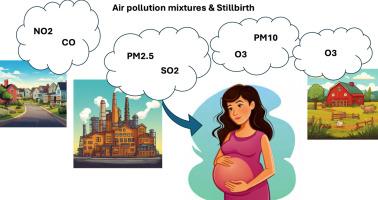空气污染混合物与死产:k均值聚类分析
IF 2.7
引用次数: 0
摘要
预防死产始于确定可改变的风险因素,如空气污染(AP)。大多数研究都集中在AP的单个成分(例如PM2.5)上,以评估空气污染物浓度与死胎之间的线性关系,结果好坏参半。然而,我们呼吸的空气是气体和颗粒的混合物。本研究的目的是评估美国标准空气污染物的混合物与死产的关系。材料和方法使用美国环境保护署的空气污染数据和美国疾病控制与预防中心国家生命统计系统的美国出生和胎儿死亡数据。采用k-均值聚类对空气污染物暴露进行聚类。在回归分析中使用了将每个患者与其中一个集群联系起来的分类变量。结果通过k-means鉴定出4个AP聚类。与聚类3(参考文献)相比,妊娠期间暴露于聚类1、2和4中的空气污染混合物与死产几率分别增加40%、13%和43%相关(OR = 1.40, 95% CI: 1.36-1.44, p<0.001; OR = 1.13, 95% CI: 1.09-1.16, p<0.001; OR = 1.43, 95% CI: 1.38-1.49, p<0.001)。与死产几率最高相关的空气污染集群PM2.5和SO2含量较高,这可能表明工业来源。据我们所知,这是第一个使用k均值聚类来评估空气污染混合物对死胎影响的研究。这种方法可用于确定空气污染混合物与健康结果之间的非线性关系。本文章由计算机程序翻译,如有差异,请以英文原文为准。

Air pollution mixtures and stillbirth: k-means cluster analysis
Background
Preventing stillbirths starts with identifying modifiable risk factors, such as air pollution (AP). Most research has focused on individual components of AP (e.g. PM2.5) to assess the linear relationship between air pollutant concentration and stillbirth, with mixed results. However, the air we breathe is a mixture of gases and particles. The purpose of this study was to assess how mixtures of criteria air pollutants are associated with stillbirth in the United States.
Materials and Methods
Air pollution data from the US Environmental Protection Agency and individual US birth and fetal death data from the CDC National Vital Statistics System were used. Air pollutant exposures were clustered using k-means clustering. A categorical variable linking each patient to one of these clusters was used in a regression analysis.
Results
Four AP clusters were identified through k-means. Exposure to air pollution mixtures included in Clusters 1, 2, and 4 during pregnancy was associated with a 40%, 13%, and 43% increase in the odds of stillbirth, compared to Cluster 3 (reference), (OR = 1.40, 95% CI: 1.36-1.44, p<0.001; OR = 1.13, 95% CI: 1.09-1.16, p<0.001; OR = 1.43, 95% CI: 1.38-1.49, p<0.001), respectively.
Discussion
The air pollution cluster associated with the greatest odds of stillbirth was high in PM2.5 and SO2, which may indicate industrial sources. To our knowledge, this is the first study to assess the impact of air pollution mixtures on stillbirth using k-means clustering. This method can be used to identify non-linear relationships between mixtures of air pollution and a health outcome.
求助全文
通过发布文献求助,成功后即可免费获取论文全文。
去求助
来源期刊

Hygiene and environmental health advances
Environmental Science (General)
CiteScore
1.10
自引率
0.00%
发文量
0
审稿时长
38 days
 求助内容:
求助内容: 应助结果提醒方式:
应助结果提醒方式:


